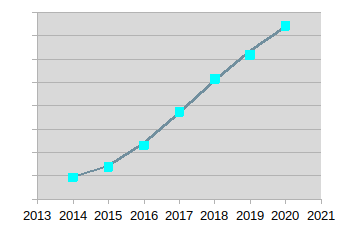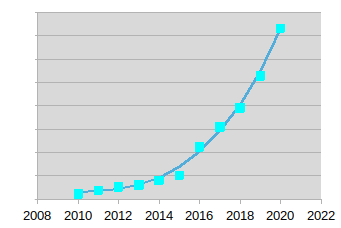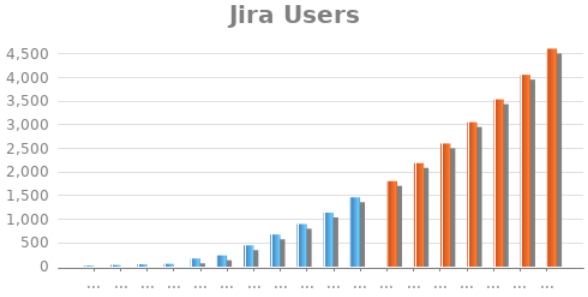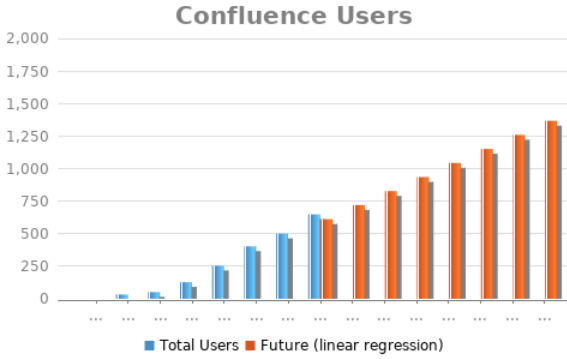...
Atlassian are discontinuing their 'Server' (self-hosted) product line in favor of the Cloud alternatives. This affects us, as we are using both Jira Server and Confluence Server.
...
Atlassian is pushing the majority of customers to Cloud. The 'Data Center' (DC) product line, a clustered edition for large instances, will still be available, but its price will be increasing by 15-180%.
| Anchor | ||||
|---|---|---|---|---|
|
Summary: Future Pricing
The three options Atlassian make available to us are:
- Stay with Server as long as possible, then migrate to DC (option 1).
- Migrate to DC soon to get ourselves a 'advantaged' (grandfathered) license (option 2).
- Migrate to Cloud (option 3). Cloud may not be possible for us due to GDPR compliance and lack of certain plugins. See discussion below.
Here are the anticipated prices for each option, taking into account projected user count growth and various short-term discounts. There are two DC columns because the price for DC will be different (for a while) if we act before Feb 1, 2021 and get on a 'grandfathered' / advantaged plan to escape the 15-180% price hike coming then.
Current/Past Pricing (2020)
We will consider
We paid $17,500 in 2020 to renew Jira license. Jira's license expires in July 2021.
We paid $13,100 in 2020 to renew Confluence. Confluence's license expires in Feb 2021.
Both these prices were artificially low, as we are on an 'advantaged' (grandfathered) plan that escaped the 2019 price increases (non-grandfathered renewal costs were $30,000 and $22,500 for Jira and Confluence respectively).Our base spend (Jira + Confluence) will thus increase 10x or 11x from its current $30,600
Plugins are not considered here as their costs are dwarfed by the base costs, but increases moving to Cloud can be assumed (e.g. 20% for Tempo Timesheets, 600% for JETI).
Recommendations
As an Atlassian product consultant I am very unimpressed with Atlassian's move. I have written up my (sanitized) thoughts on this move on my website. I have also put up a website for exploring alternatives products, for users for whom a 10-11x price increase is infeasible:
In that context, what would I recommend?
The least disruptive move would be to move to Data Center, assuming we can afford it (the 'DC, after Feb 1, 2021' column). Moving early will lock in some discounts. Just be aware that DC is an annual subscription, not a perpetual license like Server, and that DC won't last forever (see blog post Betting on Atlassian DataCenter?). As happened with Server, DC is likely to undergo constant price increases to 'squeeze' larger customers onto Cloud.
If we don't want to jump to DC or Cloud just yet, my suggestion is lock down Jira and wait for better alternatives. There are no good options now, we have no pressing need to move, so let's just batten down the hatches, save some money and see what alternatives emerge.
This "lock down and wait" approach can be realised in 4 steps:
Step 1: Pay Atlassian one more time for upgrading Jira's 2,000 user license to 10,000 users
One more upgrade buys us license slot headroom beyond 2022:
Do not pay for further Server renewals. Atlassian haven't added any serious feature improvements in years, and certainly won't do so now. Bug fixes are nice, but after 18 years of development there aren't many bugs left that affect us and that Atlassian are willing to fix. Atlassian support on its own isn't worth paying for.
On the other hand, we do need ongoing security patches if we are to run a public-facing instance. Which is why:
Step 2: Move customer support to an external Cloud-managed system
Implement a new public-facing system for customer support. Perhaps Jira Service Desk (JSD) Cloud where non-agents are free, or ServiceNow.
If we break our Jira active users into employees and customers, we see that employees are growing linearly, whereas customer accounts are increasing non-linearly:
...
...
Summary: Future Pricing
The three options Atlassian make available to us are:
- Stay with Server as long as possible, then migrate to DC (option 1).
- Migrate to DC soon to get ourselves a 'advantaged' (grandfathered) license (option 2).
- Migrate to Cloud (option 3). Cloud may not be possible for us due to GDPR compliance and lack of certain plugins. See discussion below.
Here are the anticipated prices for each option, taking into account projected user count growth and various short-term discounts. There are two DC columns because the price for DC will be different (for a while) if we act before Feb 1, 2021 and get on a 'grandfathered' / advantaged plan to escape the 15-180% price hike coming then.
Our base spend (Jira + Confluence) will thus increase 10x or 11x from its current $30,600
Recommendations
As an Atlassian product consultant I am very unimpressed with Atlassian's move. I have written up my (sanitized) thoughts on this move on my website. I have also put up a website for exploring alternatives products, for users for whom a 10-11x price increase is infeasible:
In that context, what would I recommend?
The least disruptive move would be to move to Data Center, assuming we can afford it (the 'DC, after Feb 1, 2021' column). Moving early will lock in some discounts. Just be aware that DC is an annual subscription, not a perpetual license like Server, and that DC won't last forever (see blog post Betting on Atlassian DataCenter?). As happened with Server, DC is likely to undergo constant price increases to 'squeeze' larger customers onto Cloud.
If we don't want to jump to DC or Cloud just yet, my suggestion is lock down Jira and wait for better alternatives. There are no good options now, we have no pressing need to move, so let's just batten down the hatches, save some money and see what alternatives emerge.
This "lock down and wait" approach can be realised in 4 steps:
Step 1: Pay Atlassian one more time for upgrading Jira's 2,000 user license to 10,000 users
One more upgrade buys us license slot headroom beyond 2022:
Do not pay for further Server renewals. Atlassian haven't added any serious feature improvements in years, and certainly won't do so now. Bug fixes are nice, but after 18 years of development there aren't many bugs left that affect us and that Atlassian are willing to fix. Atlassian support on its own isn't worth paying for.
On the other hand, we do need ongoing security patches if we are to run a public-facing instance. Which is why:
Step 2: Move customer support to an external Cloud-managed system
Implement a new public-facing system for customer support. Perhaps Jira Service Desk (JSD) Cloud where non-agents are free, or ServiceNow.
If we break our Jira active users into employees and customers, we see that employees are growing linearly, whereas customer accounts are increasing non-linearly:
| Employee Jira Users | Customers |
|---|---|
Moving customer support to JSD Cloud means that non-linear growth isn't a problem: we don't pay for customers, only for 'agents'. Moving our customers to a Cloud product should be a net win for security.
Step 3: Lock down Jira to just employees
Jira averages about 1 'critical' security vulnerability every 6 months (generally a CSRF). If we stop paying Atlassian maintenance fees, or run Jira beyond 2024, we need to mitigate security vulnerabilities ourselves, which we can only realistically do by locking down Jira. Either:
- put Jira behind the VPN, with holes poked for Github and external services, or
- put Jira (and Confluence) behind Keycloak or a commercial IAM (Google, Ping, Okta, Cloudflare Access etc).
We could further lock down Jira by adding a WAF like mod_security or Cloudflare, so that security vulnerabilities we learn of can be mitigated at the HTTP layer.
Step 4: Look for alternatives
With customers out of the picture and Jira locked down to employees, we can take our time evaluating Jira Server alternatives.
Realistically, Jira Cloud might still end up being our best option. Even if that turns out to be the case, I'd argue that waiting a few years can only benefit us. Today Jira Cloud is an immature, over-priced product, with poor performance, a weak plugin ecosystem and unclear GDPR compliance prospects. Many ecosystem vendors (
Moving customer support to JSD Cloud means that non-linear growth isn't a problem: we don't pay for customers, only for 'agents'. Moving our customers to a Cloud product should be a net win for security.
Step 3: Lock down Jira to just employees
Jira averages about 1 'critical' security vulnerability every 6 months (generally a CSRF). If we stop paying Atlassian maintenance fees, or run Jira beyond 2024, we need to mitigate security vulnerabilities ourselves, which we can only realistically do by locking down Jira. Either:
- put Jira behind the VPN, with holes poked for Github and external services, or
- put Jira (and Confluence) behind Keycloak or a commercial IAM (Google, Ping, Okta, Cloudflare Access etc).
We could further lock down Jira by adding a WAF like mod_security or Cloudflare, so that security vulnerabilities we learn of can be mitigated at the HTTP layer.
Step 4: Look for alternatives
With customers out of the picture and Jira locked down to employees, we can take our time evaluating Jira Server alternatives.
Realistically, Jira Cloud might still end up being our best option. Even if that turns out to be the case, I'd argue that waiting a few years can only benefit us. Today Jira Cloud is an immature, over-priced product, with poor performance, a weak plugin ecosystem and unclear GDPR compliance prospects. Many ecosystem vendors (notably Tempo) are still scrambling to sort out their Server-to-Cloud migration pathways. Yet Atlassian are betting hard on Cloud, and in 5 years' time Jira Cloud will be much more compelling, and the migration process much smoother.
...
| Jira | Confluence | |||||
|---|---|---|---|---|---|---|
Jira has a 2000 User license, with 1463 license slots used as of . License use is increasing each year (despite automatic deactivation after 6 months' inactivity). This shows that if current growth continues we will hit our 2000-user license limit in early-2022, and will be forced into Jira's next user tier, 10,000 users.
| Confluence is also on a 2000 user license, with 650 license slots used as of . Growth appears linear. No 'deactivate inactive user' process is being run yet. |
Past Pricing (2020)
We paid $17,500 in 2020 to renew Jira license. Jira's license expires in July 2021.
We paid $13,100 in 2020 to renew Confluence. Confluence's license expires in Feb 2021.
...
license, with 650 license slots used as of . Growth appears linear. No 'deactivate inactive user' process is being run yet. |
| Anchor | ||||
|---|---|---|---|---|
|
Option 1: stick with Server as long as possible, then move to Data Center
...





